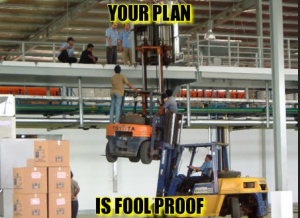As the majority of my career has involved forklifts, I decided to do a mini-series of blog posts about forklifts. This is part 2.
Forklift safety is very crucial, especially when you are dealing with aerial lifts such as scissor lifts and boom lifts. When working in an environment with forklifts, some basic safety tips may come in handy. While forklifts are usually designed with safety in mind, they have been found to cause a few accidents every year due to falls, collapses or tip-overs. Fortunately, it is possible to avoid these accidents, if only you maintain the standard safety precautions and ascertain the forklift operator has proper certification from a forklift train the trainer course
– Always maintain a distance of about ten feet away from any obstructions, such as electrical wires that may get in the way and cause the worker to trip over. If it is necessary for the worker to work in close proximity to any of these things, observe precautionary measures to keep him safe while on the forklift. In addition, never linger around, stroll close to or climb onto elevated forks in case of a sudden move.
-When carrying a load, ensure that it is centered as accurately as possible. In addition, make sure that the heaviest part of the load is as close to the front as possible for forklift safety. Handling a load that is not centered can be difficult, and if you fail to position its heavier portion at the front, it could tip over. As a general thumb of rule, the forklift should always be able to handle the load being exerted on it, and not more.
-Never load the machine beyond its maximum capacity, otherwise you may risk breaking the lift or causing an accident. When approaching a load, always ascertain the load is directly in front of the forklift, not too far or too near.
-No unauthorized person should be allowed near the forklift, even if they claim to know how to operate it. There is a reason for training and qualification; do not undermine the system. Moreover, unless the machine is designed for multiple persons, never allow anyone else inside the cockpit when you are operating it.
-Before driving the lift between two points, despite the distance between them, make sure you lower it completely. Driving over uneven terrain or on inclines is especially dangerous as it causes the weight of the load to shift to one side, leading to tip overs.
-Do not tilt the forks forward while driving as this could destabilize the load and/or cause the forklift to become unstable itself. When using the forklift to raise workers to at an elevated site, make sure that the forklift you are using was specifically designed with an inbuilt platform to support human life.
-Some forklifts are not people friendly, and a worker may lose their footing on a standing area or platform that is unstable and is not secure enough to protect against falling incidents.
-It is always advisable to check the overhead when lifting a load, for clearance. Make sure that the overhead is free of any lights, pipes or sprinklers that could be damaged by the load being raised.
-In addition, always conduct your standard personal safety routine on a daily basis before using your forklift. Make use of the forklift safety gear to ensure the protection of both the operator and workers on the site.
